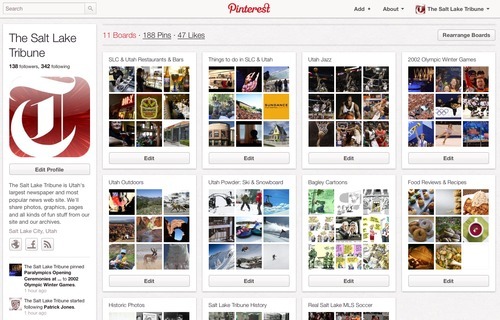This is an archived article that was published on sltrib.com in 2012, and information in the article may be outdated. It is provided only for personal research purposes and may not be reprinted.
So what's all this insane interest in Pinterest?
What launched in 2010 as an obscure photo-sharing site in Palo Alto, Calif., has exploded into a phenomenon that is quickly seeping into the American digital consciousness, especially among women.
"I'm addicted. I get on it at least daily," said Allison Willard, a 26-year-old hairstylist from Cottonwood Heights. "I have an app on my phone for it, and I just click on it and nonchalantly look through it."
The bulletin board-styled website in which users share photos of interests from crafts to movies and music now has more than 11.7 million monthly active users, according to metrics analysts AppData. It now drives more referral traffic than Google Plus, LinkedIn and YouTube combined, according to Shareaholic, which measures content sharing on the web. And its user base is reportedly more than 85 percent women.
It already has spawned international clones like Pinme in Russia, MarkPic in China and Pinspire in Germany. There's even Manteresting.com, a version for men that posts decidedly male-centric pictures of bacon, sports cars and slabs of steaks.
But it's the original Pinterest that has grabbed the imagination of photo-sharing fanatics everywhere.
"It's a good unwinder," 22-year-old Alyssa Jenkins, a student from Cottonwood Heights, said about Pinterest. "When you're on Facebook you feel guilty about being on it, but being on Pinterest is a better excuse. You don't feel as guilty because it feels more productive with the kinds of things that are on it."
Co-founded in 2009 by Des Moines native Ben Silbermann and first launched in beta form a year later, Pinterest is a digital pinning board in which people who find interesting pictures on the web can "pin" them to their themed boards. These boards can revolve around interests like food and recipes, do-it-yourself ideas, fashion or television shows.
Friends who follow you can then see your curated pictures. Clicking on pictures takes you to the original websites or blogs that posted the photos. While it's social in nature — you can comment on anything you see, and you can meet others and share their pictures — there is no way to directly communicate with other users.
That's what Willard likes about Pinterest — it's not exactly a social network.
"Facebook is for social networking. You go on to see what your friends did last night at the party. It's more like Twitter where they update their status," she said. "You don't see that on Pinterest. It's more of your ideas."
And fresh ideas — as varied as making bookshelves or how to cook a turkey — are why people flock to Pinterest.
"I like it for generating new ideas, but I also like it for storing old ideas," said Janette Hanagarne, 40, of West Valley City. "I find a picture or image of something that I think I want to do some day, and it's a great way to store it so I can look at it again later."
Another attractive element of Pinterest is that is has remained remarkably free of objectionable pictures, an anomaly in an anything-goes Internet steeped in graphic content. It's also been argued that the site's cleanliness and focus on homemaking and crafts have attracted a lot of Mormons to the site.
In a column about why the site attracts members of The Church of Jesus Christ of Latter-day Saints, Gawker.com said Pinterest is "the most inoffensive, white-bread place on the Internet."
"[It's] a gated community of perfectly curated boards sprinkled with Etsy-made children's toys and food blog recipes, sheltered from the blasted racist hellscape of the rest of the web," it wrote.
Simply put, "I haven't seen anything that I would be afraid to show to my kids," said Jeff Nielsen, 49, one of the minority of men on Pinterest (he along with his wife run their own LDS-themed crafts business from their Syracuse home).
"It's kind of a niche that's pretty popular among Mormon women," Hanagarne added. "You've got young mothers and they're going to be looking for creative, interesting things to do that are cheap."
So far, Pinterest has raised more than $37 million in venture capital, but it's now gearing up to find ways to earn revenue, either through advertising or using sponsored photos of products placed on the site.
"Pinterest's monetization strategy isn't in the oven and it's not even off the baking table," Jeremy Levine, a board member of Pinterest, told The Wall Street Journal earlier this year. "We have one hundred ideas but no execution as of yet."
Twitter: @ohmytech
Google+: +Vincent Horiuchi —
How to get on Pinterest
O Want to be on Pinterest? Well, hold on a second. You can't unless you're invited because the photo-sharing site is still closed to open registration.
You can get on a list to be invited by going to the site at pinterest.com and clicking on the "Request an Invite" button or getting someone who's already a member to invite you.



